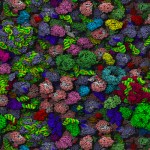CRE
Last week, the journal Antibiotic Agents and Chemotherapy posted an accepted manuscript that contains some very bad news: an easy-to-spread gene that makes bacteria resistant to an important class of antibiotics has been found in samples from a US pig farm.
A team of researchers from Ohio State University, led by Thomas Wittum, collected samples from pigs and buildings at a pig facility over five months in 2015. They found that several of the samples contained carbapenem-resistant Enterobacteriaceae (CRE). Back in 2013, CDC Director Thomas Frieden held a press briefing on this "nightmare…
Last month, researchers from China reported in The Lancet Infectious Diseases that they had identified a gene (MCR-1) that confers antibiotic resistance to a last-resort antibiotic (colistin) and then found that gene in E. coli isolates from pigs, meat, and hospital patients. This prompted Danish researchers to re-examine the genomes of bacteria they had mapped previously, and they found the MCR-1 gene in sample from a patient who suffered a blood infection in 2015. They also found it in five food samples imported between 2012 and 2014.
Mike the Mad Biologist found the plasmid and protein…
A groundbreaking study published in PLOS ONE offers hope that scientists can reverse the development of antibiotic resistance among bacteria with the help of "a mathematical model that pinpoints optimal antibiotic cycling patterns." On The Pump Handle, Kim Krisberg writes, "the research comes at a time of widespread concern that without a coordinated, well-funded response to growing antibiotic resistance, medicine could lose some of its most effective, life-saving tools." The collaboration between biologists and mathematicians yielded a piece of software dubbed "Time Machine" that "computes…
Last week, FDA warned healthcare providers that the complex design of a piece of endoscopy eqiupment may make it hard to fully disinfect -- which means that using it, even in accordance with the manufacturers' instructions, might allow dangerous bacteria to spread between patients. The warning follows reports of seven patients from UCLA's Ronald Reagan Medical Center becoming infected with the drug-resistant "nightmare bacteria" CRE (Carbapenem-Resistant Enterobacteriaceae) after undergoing procedures using ERCP endoscopes, or duodenoscopes. Of these seven patients, two died, and "the…
Antibiotic-resistant infections kill 23,000 people in the US and sicken two million each year, and the problem is getting worse, warns a new report from the Centers for Disease Control and Prevention. Antibiotic Resistance Threats in the United States, 2013 ranks several strains of bacteria according to their current and projected health and economic impacts. It describes 18 microorganisms whose threat levels are "urgent," "serious," or "concerning."
CDC identifies three bacteria as urgent threats: Clostridium difficile, Carbapenem-resistant Enterobacteriaceae (CRE), and Drug-resistant…
Last week, CDC Director Thomas Frieden opened a press briefing by saying, "It's not often that our scientists come to me to say that we have a very serious problem, and we need to sound an alarm." What scientists found, and reported in CDC's Morbidity and Mortality Weekly Report, is that a growing proportion of Enterobacteriaceae (a family of bacteria known for causing hospital-acquired infections) are resistant to carbapenems, a type of antibiotics that's typically been the last line of attack against stubborn infections. Frieden explained why these carbapenem-resistant Enterobacteriaceae (…

